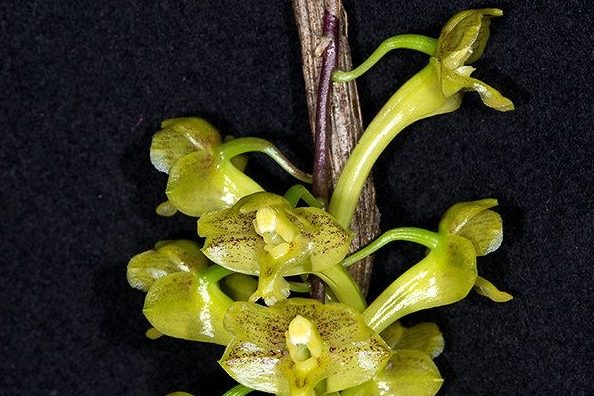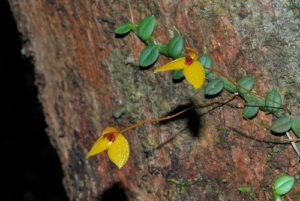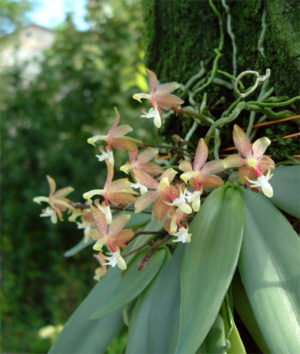
Deforestation in Borneo is proceeding at an alarming pace
The island of Borneo has been in the news about conservation lately, due to massive deforestation that is occurring there. Just imagine, the amount of rainforest already lost in Borneo is equal to four times the size of Switzerland. Not only does that mean loss of habitat for many plant and animal species, it also means a loss of the world’s carbon sink (taking in carbon dioxide, returning oxygen to the atmosphere), as well as endangering the livelihood of indigenous people. This is not how Borneo should look, and it is not how I have always pictured it in my mind.
The Magic of Borneo
The word “Borneo” has always conjured up an image of someplace truly exotic, full of mystery and promise of new discoveries. I am reminded of this each time I walk out to my greenhouse, because one of my earliest orchid purchases (1983) happened to be a species from Borneo. It is called Rhynhcostylis gigantea variety Sarawak.
The island of Borneo is composed of three nations, the largest being Indonesia. To the north and west are Saba and Sarawak, which are the two states comprising Malaysia. And in between the two Malaysian states sits the tiny sultanate of Brunei. This concludes your geography lesson for today.
I wish I could say that my motivation for writing this article is to “revisit” this island. Sad to say, I never had the opportunity to visit Borneo; my orchid was actually purchased in Thailand. But I have written about Borneo in earlier Conservation Updates so it is almost the same thing, right?
Orchids in Borneo are threatened due to deforestation

Bulbophyllum catenarium
I do have a specific motivation for writing about Borneo, however. It comes from the April 2016 edition of Orchid Digest which features an article by Charles G. Wilson, retired Director of the Memphis Zoo and member of the AOS Conservation committee. This well written article entitled “Postcard: Orchids of Borneo” describes a 12-day tour with the Memphis Zoo photo safari program. It takes the reader on a journey from the Crocker Mountain Range and the Tenom Orchid Centre in north central Borneo, through the Kinabalu National Park, a world Heritage site near Mount Kinabalu, known as one of the world’s richest areas of floral biodiversity, with 1400 orchid species, 26 rhododendron species, 400 ferns, and 10 pitcher plants. The tour ends at Danum Valley, an area containing 108,000 acres of virgin rainforest, a critical habitat for many endangered species, including the critically endangered orangutan.

Grosourdya appendiculata
Borneo is rich in dendrobiums and bulbophyllums. Wilson’s article documents photographically the Dendrobium panduriferum as well as the bulbophyllum catenarium found during their tours. His group also photographed Paphiopedilum rothschildianum, Eria lasiopetala, Plocoglottis gigantea, Stichorkis labongensis and Plocoglottis lowii. It is estimated that between 12,000 and 13,000 plant species are found in Borneo, with up to 1,500 orchid species among 150 genera.
Conservation research on Borneo orchids
For those interested in learning more about Borneo and its wealth of orchids, the September 1994 AOS Bulletin featured a wonderful 3-part series called “New Orchid Records from Borneo” by Jeffery Wood, deputy curator of the orchid herbarium at the Royal Botanic Gardens, Kew and Tony Lamb, a 30-year resident of Sabah and creator of the Orchid Centre at the Agricultural Research Station in Tenom.
Research facilities located in the native areas of these orchids are key to orchid conservation. By situating their work in the local areas, conservationists like Jeffery Lamb are able to keep many of the species in cultivation on site, such as the unique Grosourdya appendiculata shown here.
Local orchid societies are getting involved
In a unique way we in the Greater North Texas Orchid Society have helped with this conservation effort. During our 2015 orchid show we held a conservation raffle through which we raised funds for the Rainforest Trust program. Our contribution helped support a project which creates a link between the Danum Valley and another sanctuary, thereby expanding protection for a critical forest region and orchid habitat. We should all pat ourselves on the back for this.
I quote from the Rainforest Trust news release:
Thanks to Rainforest Trust donors, a major logging concession in Sabah, Borneo, has been converted into a 168,032-acre permanent sanctuary for wildlife that links two of the most important reserves in Asia – the Maliau Basin and Danum Valley – saving one of the most critical stretches of lowland rainforest remaining on the island.
Rainforest Trust in collaboration with Bornean partners Yayasan Sabah Foundation, the Royal Society South‐East Asia Rainforest Research Program (SEARRP), and Permian Global worked with Sabah’s state government to formally establish the new Kuamut Forest Reserve. Its protection comes after intense pressure to open these forests to repeated logging and oil palm development.
“The Kuamut Forest Reserve is a crucial link in a huge protected area complex extending across more than 77 miles of lowland rainforest and encompassing a wide variety of habitats for wildlife,” said Dr. Paul Salaman, CEO of Rainforest Trust. “After a struggle against logging and oil palm companies and their desire to open up these forests to development, we have finally secured protection for this exceptional area. The declaration of the Kuamut Forest Reserve is one of the greatest refuges for biodiversity in all of Borneo.
This project is an excellent example of ways we can be a part of orchid conservation throughout the world. By supporting major organizations like the Rainforest Trust, the Orchid Conservation Alliance, and the North American Orchid Conservation Center we can preserve and protect critical habitat. Currently the Rainforest Trust is in the planning stages of a project which will protect an additional 113,668 acres of Kuamut’s forests by 2018. I will do my best to provide incentives for our organization to support this exciting and worthwhile project.
You will be happy to know that my Rhynchostylis gigantea is thriving. It keeps alive my enchantment with rainforests like the ones in Borneo, and even provides inspiration for my art.
Read about the condition of Borneo’s rainforests here.
![]()